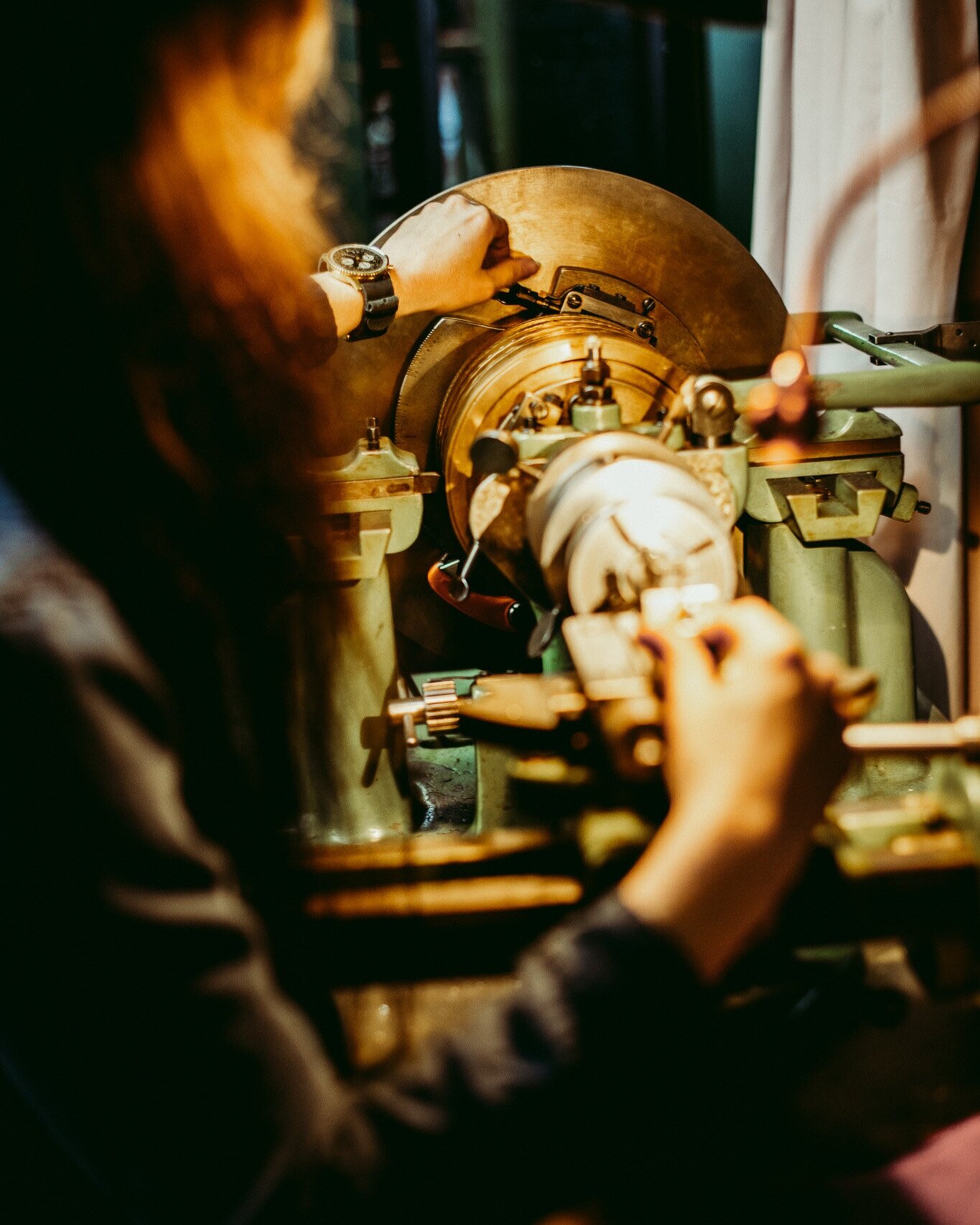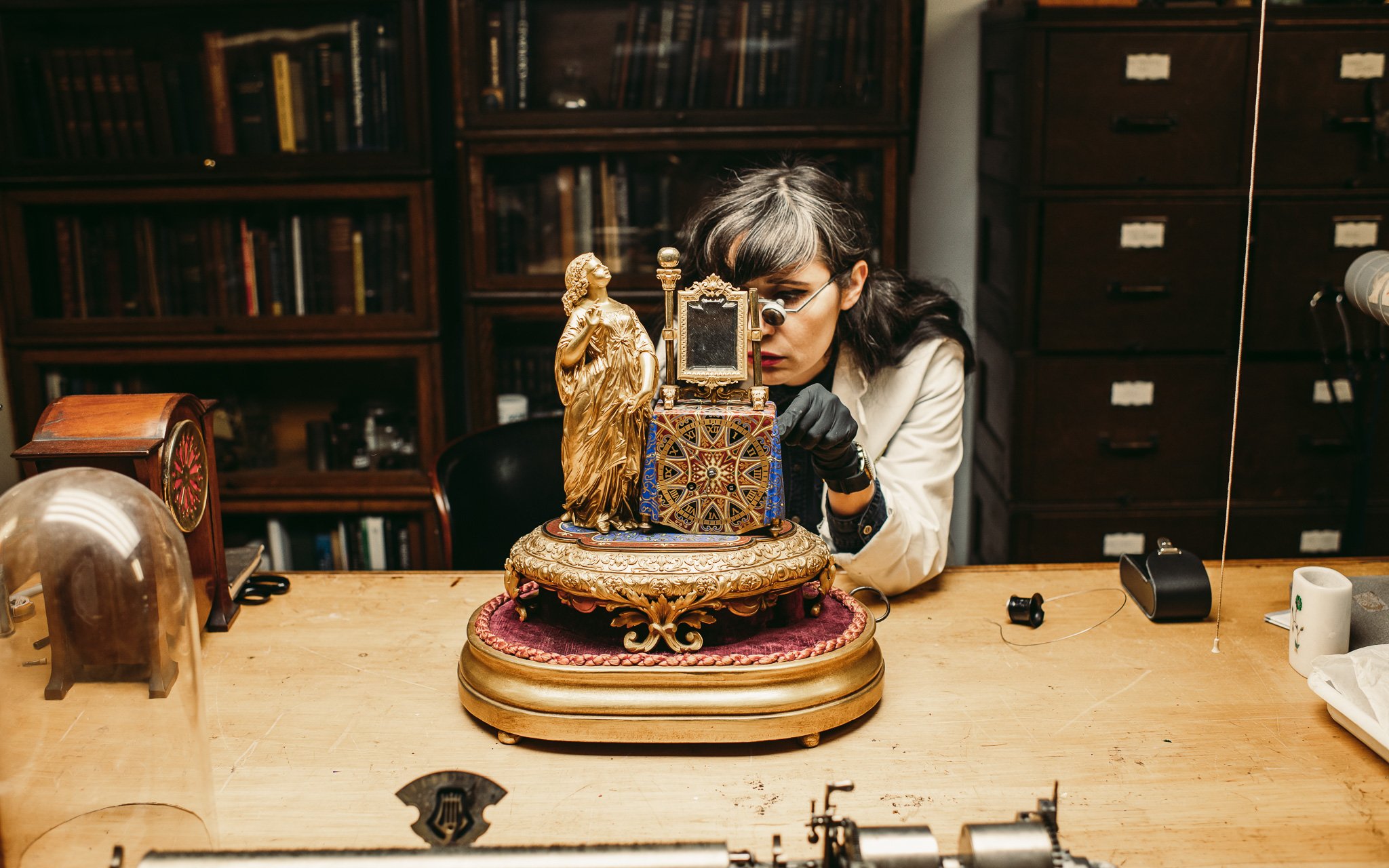A Matter of Time
For Brittany Nicole Cox, Repairing Old Clocks and Automata Isn’t Just a Matter of Saving Objects From Obsolescence. It’s About Keeping the Past Alive.
Originally Published in Smith Journal
Words by Taz Liffman
LIKE MANY OF US, BRITTANY NICOLE COX SPENDS MUCH OF HER WORKING DAY WATCHING THE CLOCK. UNLIKE MANY OF US, SHE ISN’T PROCRASTINATING OR COUNTING DOWN THE MINUTES TILL HOM TIME WHEN SHE DOES THIS: SHE’S WORKING.
“I’m an antiquarian horologist,” she explains, seated amid a jumble of whirring, ringing, chiming contraptions in her Seattle workshop. “Horology is the study of time, and I’m a certified watchmaker who specializes in restoring antique horological objects. I keep time ticking.” Her days are spent pulling clocks and other mechanical oddities apart, working out what makes them tick, then putting them back together. It’s an interest that began in childhood. “I was always collecting things that seemed to operate within rules,” she says. “Magnets, springs, compasses, watches, musical boxes, and so on.” Soon enough she began taking these things apart to figure out what those rules were – though Cox is quick to point out that this only held true for some items. “My things were very dear to me, so I’d only ever take them apart to a point. As for Dad’s stuff, that was a different story. I was always getting in trouble for sneaking into his garage and pulling his things apart.”
Thankfully for her father, Cox eventually found something less breakable to deconstruct. As a young adult she swapped her toolbox for a library card, began reading vociferously, and was soon disassembling thought itself. She studied philosophy at the University of Texas, where she immersed herself in epistemology, the branch of philosophy concerned with the theory of knowledge, and metaphysics, which deals with the first principles of abstract concepts, including time. For Cox, it made sense that something as intangible as philosophy still had a grounding in mechanics and logic: that by pulling the casing off knowledge itself you could decode how it worked. Trailing the history of these philosophical schools took her back to the objects that had so enraptured her during childhood.
“I got really interested in how people were looking at these philosophical quandaries hundreds of years ago,” she says. “Cognitively and technologically, 17th-century Europe was a really fascinating time.” In previous eras, societies had looked to religious or supernatural sources to explain the nature of reality. By the 1600s, more and more people were using the rubric of science to answer those same questions – and the prevailing scientific innovations of the time were mechanical. “They were starting to see the world as a giant machine that had God as its mechanic,” Cox explains.
One of these 17th-century innovations was a craft called ornamental turning, which uses geometric principles to cut precise, circular patterns on surfaces with a lathe. Initially valued for the finely decorated bowls, plates and boxes it produced, the hobby became a favoured pastime of princes and kings looking to substantiate their fitness to rule. As the logic went, God was the perfect ruler because He had created (and turned) the perfect sphere (Earth). If you, too, could master the art f turning, your royal self would therefore be more God-like.
Slowly, the art of ornamental turning progressed into the creation of automata: mechanical devices that used clockworklike tech to create facsimiles of living things. These, Cox says, constituted our species’ first attempts at creating artificial intelligence. “People were really challenging what humanity was capable of. There was considerable interest in reanimating the dead.” Not too surprisingly, some of these attempts ventured into slightly eccentric territory. Jacques de Vaucanson, a French artist and inventor from the 18th century, designed androids that would serve dinner and clear the tables when politicians dropped round for dinner. (This particular vision ended when a government official, declaring Vaucanson’s ambitions “profane”, ordered his workshop destroyed. Still, Vaucanson went on to create two of the most sophisticated automata of the era: the Flute Player, a lifesized shepherd that could ‘play’ any flute put into its hands; and the Digesting Duck – a mechanical waterfowl that flapped its wings, drank water, ate grain, and defecated.)
Cox loved philosophy, but after spending so long reading about all the cogs and gears that so intrigued her as a child, she decided to pursue a more hands-on line of work. She spent the next six years studying to become an antiquarian horologist, attaining several qualifications in watchmaking and clock conservation, as well as a master’s degree in museum studies. Fortunately, all the homework has paid off. Since opening her workshop, Memoria Technica, in 2015, work has been steady, and she’s never had to advertise.
Half of her clients include museums,companies and private collectors. The other half are families looking to have heirloom clocks or automata restored. The money isn’t as good for these jobs, but Cox often finds the work more rewarding on a personal level.“If something means a lot to someone, thenI have to make sure their object is afforded the proper respect,” she explains. “That’s a part of my job I take a lot of pride in. I often feel as though I’m restoring a piece of someone’s nostalgia: that I’m returning a part of their memory.” In fact, this is where the name of her business came from: ‘memoria technica’ is a Latin term for a device that assists memory.
No matter the piece that’s brought in to her, the initial process is always the same: Cox analyses the object, and tries to ‘solve’ it like a mechanical puzzle. These old machines don’t come with instruction manuals, so she has to rely on her technical knowledge and investigator skills to reverse-engineer how they work. Getting inside their creators’ heads is part of the job. “The vast majority of automata were made by hand,” Cox explains. “The objects have stories. They carry lived histories. You can tell that the peoplemaking them had good days and bad days.”
Once a course of action has been decided on,the real work begins. Spare parts are rarelyavailable, so Cox often ends up making herown replacement pieces. Failing that, shemakes the piece that will enable her to makethe piece she needs. Asked whether she hasever been defeated by a job, she shakes herhead. That would mean giving up, which is one thing Cox doesn’t know how to do. Of all the abilities required to be an antiquarian horologist – good hand skills, an aptitude for critical thinking and problem-solving – Cox identifies patience and perseverance as the most essential. “You need to be up for tackling small problems all day. Making tiny decisions on minute levels with very fine tolerances. And you need to accept that you might have to redo a thing several times before it works.”And when it does work? Cox describesthe experience as one of complete elation.“Hearing a bird sing that maybe hasn’t sung for a hundred years, it’s kind of surreal,” she says. “You’ve given hours and hours to an artificial living thing, and then all of a sudden it’s there singing, just for you. You’re overcome with this incredible joy, and also wonder. Because a very small, very human part of you is still going: How does it work?”
Perhaps the most peculiar thing about the craft is how much time is dedicated to measuring time itself. “As a conservator, my job is to try and prevent an object from ageing further than it already has,” Cox points out. “I’m attempting to arrest time’s disintegrating of the object. And yet, at the same time, the object’s purpose is to count the passing of time – so in that sense I’m trying to keep it going. I’m trying to ensure that time keeps moving at the same time as I’m trying to prevent time from happening to it.”









